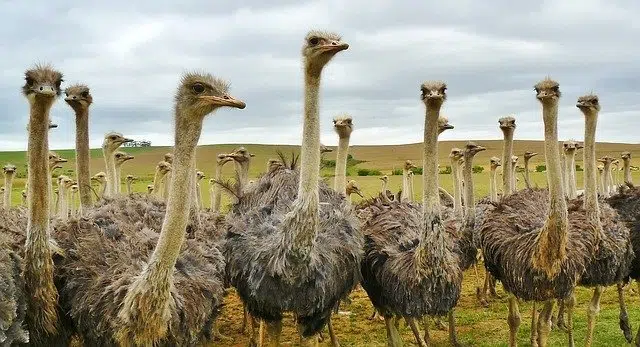
The ostrich is the largest and heaviest bird in the world.
The notion of ostrich has a long etymological history. Its origins date back to the Greek strouthíōn , which led to the Latin struthĭo . This word passed into Occitan as estrutz , later transformed into estruz .
An ostrich is a flightless bird . It is known above all for the immense size of its body and the length of its neck. It must be considered, however, that there are different species, each with its own particularities.
Physical characteristics of the ostrich
Ostriches are part of the order Strucioniformes . With the scientific name Struthio camelus , the common ostrich is the heaviest and largest bird in the world: there are specimens that exceeded 180 kilograms and approached 3 meters in height .
Present on the African continent and in Arab territories, it can run very fast thanks to its elongated legs. On the contrary, its small wings and weight prevent it from flying.
It should be noted, however, that the wings are useful to the ostrich. In addition to providing momentum and balance when moving, you can shake them to defend yourself from various animals .
Other physical features of the ostrich are the contrast between its large eyes and its small head ; its neck of great length and without feathers; and its muscular and strong legs. These legs allow it to run at about 70 kilometers per hour and kick as a defensive resource.

There are ostrich farms intended to obtain feathers, meat and eggs.
Feeding and reproduction
Due to its biological and anatomical characteristics, the ostrich does not chew its food: after taking it with its beak, it directs it directly to the esophagus. This is because their tongue moves little since it has no teeth.
The fruits and flowers are its main food resource. However, they can also eat arthropods and other small animals. In some cases, they ingest carrion.
Regarding its reproduction , the ostrich reaches sexual maturity at around 3 years. Females usually reach it a little earlier than males. Due to increased testosterone, the neck of males becomes reddish in the mating season. The specimens also reinforce their territoriality.
After a courtship that lasts about 10 minutes, copulation comes. Once fertilization has been achieved, the female places the eggs in a nest built by the male. Then, both take turns incubating them.
The human being and the ostrich
There is a subspecies of ostrich that arose from the crossing of two species , known as the domestic ostrich . It is smaller than other varieties of this animal and, as it shows little aggression, it can be kept in breeding facilities.
At this point, it is important to highlight that humans exploit the ostrich to obtain eggs , meat and leather . Their feathers are also used. There are ostrich farms in countries such as the United States , Spain , Australia , South Africa and Israel that make farming of this type possible.
Ostrich meat is valued for having a reduced level of cholesterol and a high amount of iron compared to others. It is interesting to note that it is considered red meat despite coming from a bird.
Sausages and stews are prepared with this meat. You can even eat it in steaks or hamburgers , for example .
